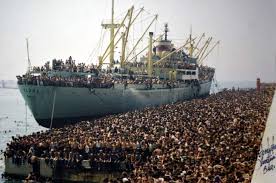EMIGRATION FROM ITALY (1996-2005)
At the beginning of the 21st century, the emigration flow from Italy to other countries of the world started to concern a quarter of young and graduated people (this took the name of “brains escape”). It’s a brand new kind of immigration, and it’s different from the previous centuries’ one. The “brains escape” defines a temporary emigration (as most of the people say) of young people with medium or high level of qualification to lots of foreign countries. As Svimez (Southern Italy Development Institute) says, since 1995 we can see the level of “internal immigration” getting higher and higher: the migrants still come from the South of Italy, but with a different destination: North-Eastern and Central one. The most involved regions are Lombardia, Veneto, Emilia-Romagna, Toscana and Umbria.

image from: https://www.google.it/url?sa=i&rct=j&q=&esrc=s&source=images&cd=&cad=rja&uact=8&ved=0ahUKEwiIm4uU9dXSAhXJVxQKHdDQALoQjRwIBw&url=https%3A%2F%2Fit.wikipedia.org%2Fwiki%2FFile%3AFuga_dei_cervelli.jpg&psig=AFQjCNHY-81GajrC5GfxjMTs0gbadxlaBQ&ust=1489578145397791
As we said, this kind of migration is really different from the “traditional one”. For example, it’s not the whole family to move, but just a single person: they move alone, usually commuting, and sharing house with other people. About South-to-North migration, we have to talk about those graduated people who can't find a job in their area, so they have to go to the northern regions to find it: there, jobs like doctor,teacher, lawyer or engineer are really required (especially those ones related to school). Then, lots of young people go to North to join the army or the police, serving in the barracks.
IMMIGRATION TO ITALY (1996-2005)
In 1991 Italy had to face the first wave of "mass migration" from Albania (caused by the collapse of the communist block), between march and august of that year, which was solved with bilateral agreements. In the following years more bilateral agreements have been stipulated with other countries, especially the Mediterranean ones. According to some data from Caritas, in 1996 in Italy there were 924.500 foreigners.
Six years later the first wave, in 1997, a second one occurred: caused by the bankruptcy of several financial industries that made Albania extremely poor. It took people to Italy with the hope to find a job and a better lifestyle. Furthermore, the Kosovian war (1999) made the "invisible wave" happen: over 100.000 Albanians left their own Country asking for political asylum as Kosovian war refugees.

image from: https://www.google.it/url?sa=i&rct=j&q=&esrc=s&source=images&cd=&cad=rja&uact=8&ved=0ahUKEwjr0rn19NXSAhWKAxoKHeF4CswQjRwIBw&url=https%3A%2F%2Fit.wikipedia.org%2Fwiki%2FVlora_(nave)&psig=AFQjCNGkxEL-yWnf7XXSVgkrsciJPZP_cg&ust=1489578081324472
The Turco-Napolitano law was made in 1998: it tried to regulate entry flows, trying to discourage illegal immigration and founding, for the first time in Italy, detention centers for foreigners who were “subject to expulsion orders”. But this matter will be regulated again in 2002, with the Bossi-Fini law, which plans the possibility of an immediate expulsion of the foreigners by public forces.
The 2001 census showed that in Italy there were 1.334.889 foreigners, and biggest foreign communities were the Moroccan one(180.103 people) and the Albanian one(173.064 people); in 2005, that number had grown up in 1.990.159, and those two communities respectively had 316.000 people and 294.000 people.
Sources:
https://it.wikipedia.org/wiki/Fuga_di_cervelli,
http://rarehistoricalphotos.com/albanian-refugees-italy-1991/.
Authors:
-Andrea Cagnetti
-Giuseppe Marinacci
-Domenico Quarto di Palo